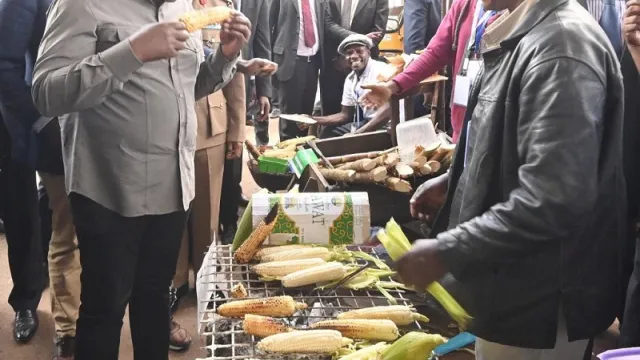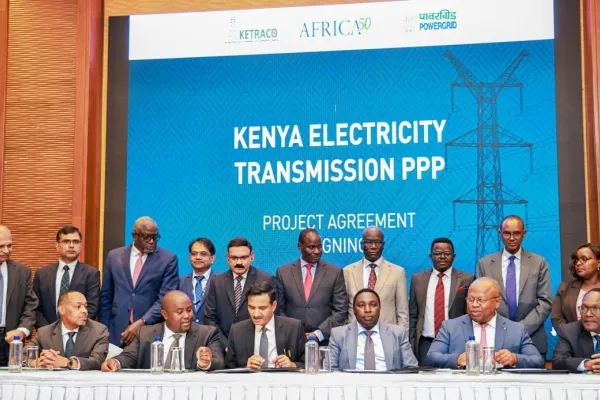The currency of debt

The currency of debt
As journalists, the cardinal rule is to tell even the most complicated story in a way ‘your grandmother’ in the village can understand. But here I was struggling to explain to my better half, NyarSindo, why her shopping is accommodating less items each month at a much higher price and the fact that the current prices will not go down even if Russia and Ukraine stop fighting or Baba gets to the doors of State House.
All attempts to explain why 9.2 percent inflation, has been caused at least in part by an increase in tax on petroleum products and Liquid Petroleum Gas (LPG), loan fees, alcohol, cigarettes and beer as well as airtime, seems unbelievable to someone who is bombarded with news of politicians promising to bring down the cost of living.
“Why don't they just reduce the taxes?” she asks. I tell her it is not just that simple. Remember ten years ago when the Jubilee government made some very ambitious promises about gigawatts of electricity, kilometres of tarmac, bullet trains, and a laptop that should be waiting for her son once he gets to school, Arrow and Kimwarer dams? These promises cost a lot of money, most of which Kenya did not have.
So, we borrowed the money to do all those things like building a fancy railway, a double decker road and concrete Kenya Power poles and forgot about most of the other fancy promises. It is now time to pay back that loan and the current inflation is actually just paying for those political promises, regardless of whether they were actually delivered or not.
But something else also happened, this loan was borrowed from another country which does not recognize Kenyan shillings. When Kenya borrowed the Eurobond in 2014, every dollar that landed in the country became 81 new shillings which should have been invested and grown to pay back the loan plus interest. But today, with the return on that Kes81 shilling doubtful, we need Kes129.9 to repay that one dollar which has meant the government needs to tax us more to pay back that loan and will need much more shillings as the currency continues to weaken.
NyarSindo knows a thing or two about debt having borrowed herself so I can explain to her that when she borrowed money the bank asked her for collateral, cash flow to determine whether she can pay. In the case of the country, where she's a taxpayer, she was the cash flow and collateral.
I think about sharing with her Ray Dalio’s how economics work to explain how debt cycles allow us to consume more than we produce when we acquire it and forces us to consume less than we produce when we have to pay it back. I explain instead for the past 10 years we were consuming more than we produce (deficit), and now the cycle has swung the other way.
She asks, if she was the collateral and the bankers knew how much taxes she generated in a year, how come the loans were not based on her ability to pay so that she should not be forced to cough out more; at least they should have known what was comfortable for Kenyans to pay back. I tell her that unlike her personal loan, a country's collateral— taxpayers—are an inexhaustible resource. A government can pledge generations upon generations as collateral and the bankers do not have to limit the loans so long as the countries pay when the debts fall due.
This cycle is, however, reliant on one thing, that there is always money to be borrowed so you can take a loan from Peter to pay Paul. This assumption has however just ended, and as Financial Times put it, African countries that have been drawing billions at the punchbowl, are staring at the risk of default now that the bowl has been removed and cheap money has disappeared when it is time to pay back.
Read also: King of crypto surviving the winter crash
A decade since Kenya joined other Africans trekking to the Eurobonds for cheap money, it is time to pay back, even as the era of easy money ends and the bankers unleash the receiver managers to tax the country into paying up.
After the 2008 financial crisis, the western governments took their taxpayers money and bailed out the bankers who had lost cash gambling on triple A- rated real estate. Handed bailout money and promised long periods of low interest rates, the bankers were seeking highly rated investments to place the next bets, and most settled on African sovereign bonds that combined high yields with the relative safety of government bonds.
Before 2008, only South Africa and Seychelles had issued Eurobonds but over the next decade, 21 sub-Saharan African countries including Kenya had had more than one dollar loan. Locally the Kenyan government used this interest to bolster legitimacy claiming the oversubscription, where demand is greater than an offer put out, was a vote of confidence on the economy rather than the cash flush global markets hunting very high returns on what they classified as risky borrowers.
The bankers could afford the risk given that unlike mortgage-backed securities, African sovereigns had the gold standard loan guarantors—the taxpayers. Credit Ratings Agencies assess a country’s ability to pay mainly by looking at its population and economic growth—the sum of all the goods and services the people produce, an effective tax system besides currency stability and manageable debt levels.
But then Covid-19 herded the world in lockdown, denying countries such as Kenya much needed dollar revenue from top income earners like tourism receipts and curtailed exports, disrupting the country’s cash flow position. The taxpayers were given a brief tax relief to cope with job losses and reduced incomes, which meant local collections for the government were also affected.
All of a sudden the risk the bankers have been pricing on Kenya’s debt became elevated according to the International Monetary Fund (the receiver managers) and the financial markets panicked, sending the pricing of Kenya’s maiden 10-year Eurobonds from 6.8 percent in March 2020 to 13.9 percent this month.
But that is not the full story, back to 2008 the bankers turned to countries like Kenya, disbursing Kes852 billion ($7.1 billion) over the years on near zero interest rates from the Federal Reserve while making huge returns. After a decade of near zero interest rates, the US Federal Reserve Bank has increased the cost of money from 0.25 percent in March this year to 4.75 percent.
If Kenya, a risky borrower according to the IMF, would approach the bankers when the cost of money was up 19 times, then the country would borrow a dollar loan at such an expensive rate that the country merely gave up on a planned issue early this year.
Cancelling the Eurobond had two consequences, we could not pay Kes90 billion of planned spending which was carried over to this financial year, and the government therefore turned to the local market, borrowing heavily and narrowing the gap between domestic and foreign loans from Kes302.4 billion in June last year to Kes2.3 billion at the end of June 2022.
But Kenya does not have the luxury to just turn away from the dollar market when creditors are at the door, such a move could risk plunging the country into a debt crisis as the World Bank warned, and so the country had to seek emergency funding from multilateral lenders in addition to taxing Kenyans to the bone.
Which brings into the equation the role of the receiver manager.
The Eurobond bankers gave Kenya billions on the confidence that the country had access to the bottomless pockets of the IMF, included in the Eurobond Prospectus incase of default. While the Fund resources are huge, cheap and accessible to countries in crisis, often the money comes with long strings attached to it, and which eventually results in the raising of taxes. If Kenya was a business, the main source of income is taxes, and the Fund’s job was to come and review the performance of the business, cut costs, seal revenue loopholes and increase taxes.
Now if the oversubscription and outpouring interest on the Kenyan bonds was an endorsement of the sovereign, it could also go that the rejection and subsequent pandering to the demands of the IMF was the surrender of sovereign control over Kenya’s resources and taxes, something closer to debt diplomacy that the West tends to accuse China of.
Since the IMF landed in town, Kenya has imposed value-added taxes on petroleum products and Liquid Petroleum Gas, increased capital gains tax, imposed excise duty on airtime and bank transactions, bank loan fees, scrapped home ownership tax exemptions, increased excise on alcohol and pledged to adjust the duty every year in line with inflation.
Kenya has also committed to increasing charges on and privatizing water, state-owned enterprises and roads, which will be accessed through toll taxes and started deducting civil servants' pay to fund pensions. To seal loopholes, the government had to sharpen the claws of the Kenya Revenue Authority which, through its multi-agency team, cracked down hard on tax evaders.
The government has also made a failed attempt to tax all businesses even if they make losses through a minimum tax after the courts blocked it while pushback against fuel taxes saw the tax charge reduced to 8 percent from the 16 percent proposed by the almighty Fund.
“There are some conditions pegged to IMF/WB DPO loans, which helps the country back on fiscal discipline. The downside of the IMF/WB programs is that they may be numb to the prevailing business cycle, and the proposed tax policies as part of the program may be counterproductive on the economy,” Churchill Ogutu, an Economist at IC Group said.

This huge rise in taxes at a time of stagnant wages that grew by a mere 2.2 percent last year to Kes69,102 on average, the slowest pace in 11 years, meant households could not afford basic items, especially during a drought year, and when prices of imported goods were also rising due to the European war and currency collapse. What all this did was isolate the President Uhuru Kenyatta’s administration, and cosmetic fixes like fuel and food subsidies could not salvage his political choice of Azimio presidential candidate Raila Odinga, who ended up losing to rival William Ruto.
While President William Ruto gained support by amplifying the ‘Hustler Narrative,’ which resonated with those at the bottom of the pyramid, in reality, his administration has been forced to talk about taxation upon assuming office, just like his predecessor.
President Ruto’s Finance Cabinet Secretary says this government targets to increase taxes from the current 13.7 per cent of GDP to 18 percent, which will mean even more pain for the average Kenyan. The new administration wants to increase National Hospital Insurance Fund (NHIF) and National Social Security Fund (NSSF) collections, tax the wealthy more and increase the number of taxpayers from the current seven million to the more than 30 million who have M-PESA mobile money accounts.
Even as the government goes for taxes, businesses are warning that Kenyans are approaching the elasticity limit, where additional taxes will hit consumption and jobs, in effect shrink collections and economic growth. Higher taxes also mean clamour for pay rises and a rise in industrial action, inflation, crime and social unrest like Raila Odinga’s Movement for Defence of Democracy tend to get outsized support.
The pain is unavoidable; the government’s only viable options are to cut expenditure, fight corruption and stimulate production through the Hustler Fund which, if well executed, could increase demand by putting money in people's pockets and kickstart small businesses while providing an avenue for future taxes. Hopefully it can avoid the fate of the Uwezo Fund that ended up in huge defaults.



